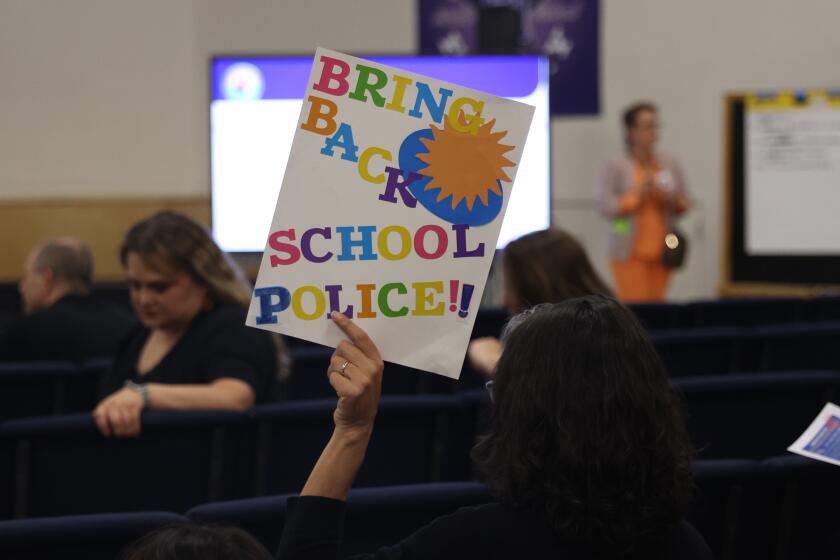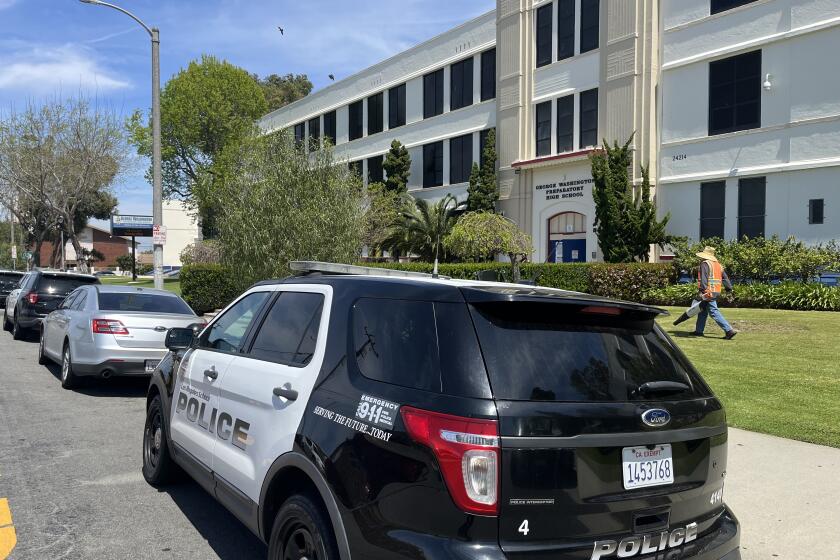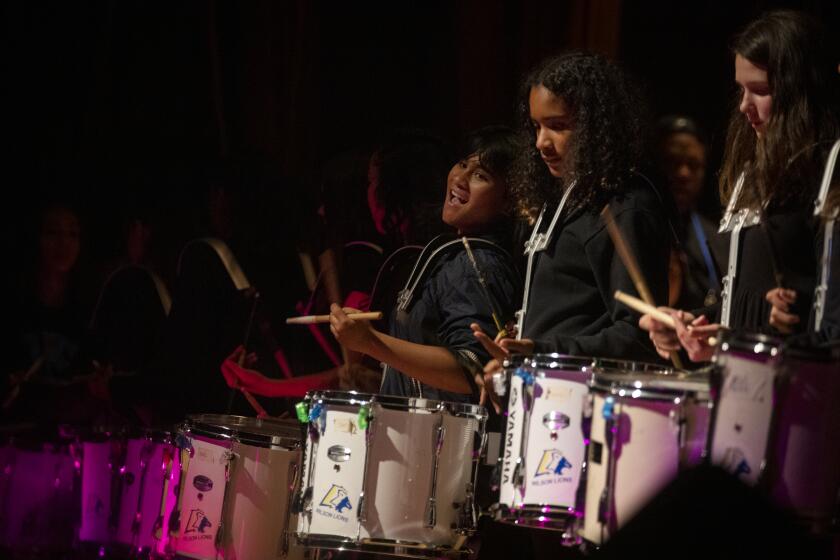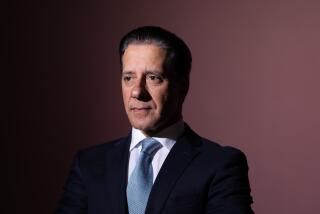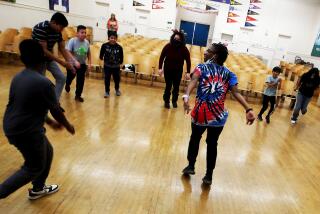Thousands rally over expected school cuts, a rebuke to LAUSD’s pledge to protect workers
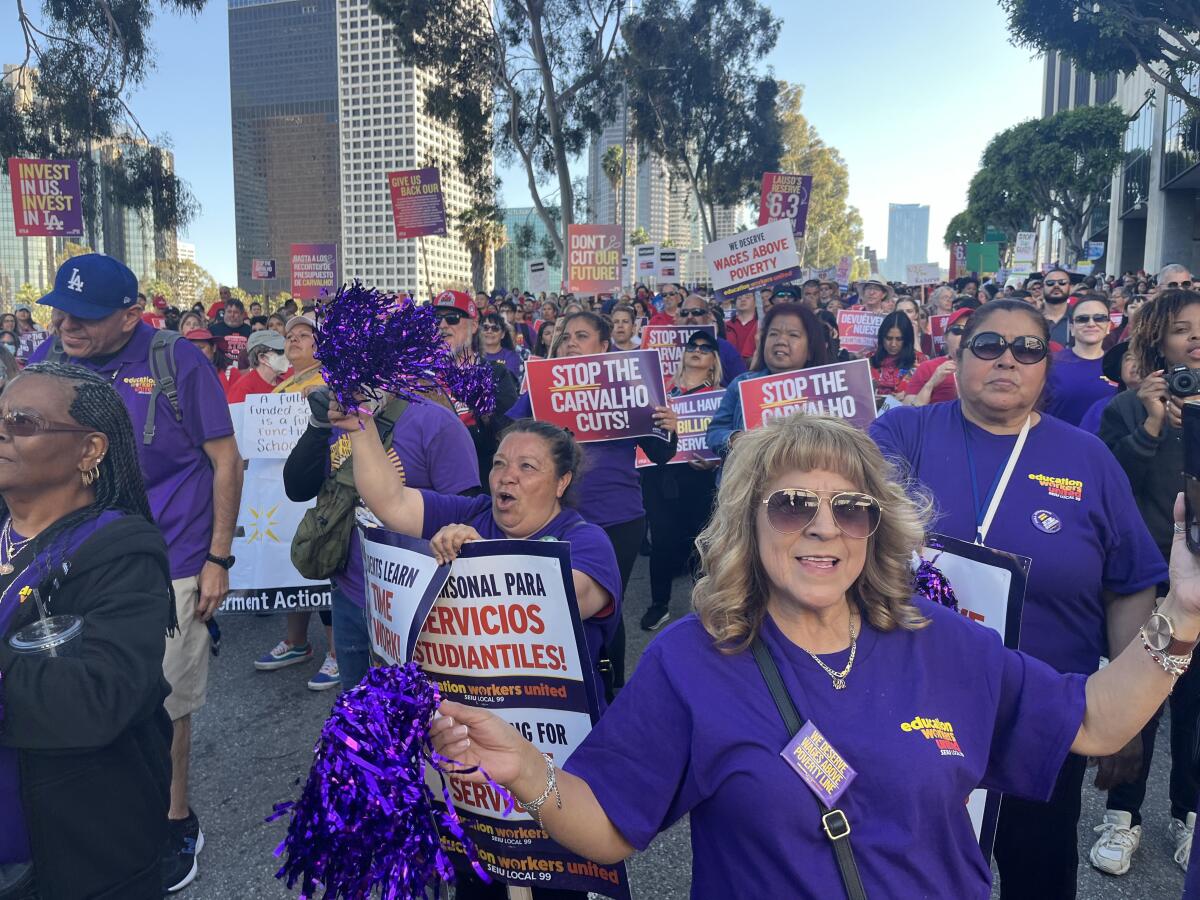
In a massive and raucous street rally Tuesday during the Los Angeles Board of Education meeting, school union leaders spoke out against expected budget cuts that are already affecting decisions at schools, where administrators have made plans to cut employee hours and programs for students.
As crowds cheered, angry union leaders lashed out against Supt. Alberto Carvalho, saying he is reneging on a pledge to protect jobs and employee benefits.
Carvalho had no immediate response — he was participating in a board meeting, hundreds of feet away inside district headquarters, in which a major focus was supposed to be school safety, a discussion that was largely postponed. But Carvalho has repeatedly said he will avoid layoffs in the face of budget shortfalls.
At a school board budget meeting last week — while also noting estimates that about 10% of school systems statewide plan to lay off workers — Carvalho repeated his pledge.
“There are over 110 districts ... right now that are facing teacher layoffs,” Carvalho said. “This is not a scare tactic. This is what we know.”
School systems statewide have had to contend with fallout from a state budget deficit and the expiration of state and federal pandemic aid.
L.A. school officials have projected general fund revenue for next year of $9.14 billion. Spending for next year is estimated at $10.89 billion. The district cannot sustain such a deficit indefinitely, officials said. Even so, cost savings have been achieved so far with limited effects on students and staff, Carvalho said.
“There is an adamant position, adopted by the board, to protect that which is indispensable and, for us, teachers and support staff are indispensable to a well-functioning, well-run school system that prizes and elevates the needs of kids,” he added. “We’ve negotiated historic salary increases — not easy, but we did it... without reducing by a single dollar employee benefits.”
With campus fights and a fatal shooting of a student near campus in spotlight, an internal task force calls for L.A. schools to have a police option, which anti-police activists oppose.
The union leaders, however, accused Carvalho of pushing cutbacks down to the school level, where school communities would have to choose which employees or programs to preserve, cut back or do without.
“We are here to expose that deception behind Carvalho’s cuts because they are deceiving,” said Max Arias, executive director of Local 99 of the Service Employees International Union, which represents the largest number of non-teaching workers, including bus drivers, cafeteria workers, custodians and teacher aides. “It’s like if we live in two worlds. We live in the real world. He lives in a world where he says there are no cuts, there are no layoffs. But they’re happening.”
Word of school-level cuts began circulating months ago — as principals began to put together their discretionary budgets. Although the district provides funding for teachers — based on the number of students — other services are up to a school. All schools would like to have an arts teacher, a psychologist, a library aide and more for five days a week. But principals — and the school leadership council — always have had to make choices.
But this year there was less money to go around for many schools as well as higher costs. Teacher aides, for example, were entitled to health benefits for the first time — a cost that was passed on to schools. And even without benefits, the lower-wage employees had received big boosts through wage agreements reached last year.
Arias estimated that about 8,000 employee hours would be lost in the next school year because of budget decisions forced on schools. He estimated this would be the equivalent of about 1,500 jobs. Arias also alluded to a situation at schools in which principals asked nonteaching workers to take lower-salaried jobs or accept fewer hours so that they would not qualify for health benefits. For the affected workers, the union, in its latest contract, had won health benefits for the first time.
“The way he has done it, it is very sneaky,” Arias said. The “principal calls you to the office and says, ‘I don’t have enough hours for you next year. So unless you cut your own hours, guess what, you ain’t gonna have a job.’ So what do people do? They cut their hours.”
An unarmed L.A. school safety worker allegedly did not intervene to stop a fight and a student died. Is it a one-off tragedy or a reason for police to return to campus?
Arias said the practice is unlawful and that the union has filed charges with the state labor board — as the unions prepare to do battle again with the district.
It’s difficult to know the extent of the practices Arias described. But one principal attested to the accuracy of Arias’ description of how employee hours are being reduced and health benefits avoided at some schools.
Local 99 settled with the school system a year ago, shortly after a three-day strike. Arias on Tuesday threatened another walkout: “You want another round? You got it.”
“Instead of being brave and being a human being that’s sincere, he’s a coward because he’s blaming others for his actions,” Arias said, referring to the cuts that principals are making.
In last week’s budget meeting, Carvalho alluded, in general terms, to situations in which employees had lost hours and benefits. He said that outcome was not what had been intended and that the issue was being addressed.
But the principal, who spoke anonymously out of concern for potential retaliation, said there’s no way to remedy the issue without providing schools with more funding.
At the rally, a teacher at King Middle School said her school had to find $800,000 in cuts.
In the budget meeting last week, Carvalho committed to additional general-purpose funding to schools and also, separately, to school arts programs that faced cutbacks. He said, too, that individual schools could petition for more dollars — provided that they included an accountability plan for the spending.
The dollar amount to be distributed and the effect are uncertain.
After Arias spoke, Cecily Myart-Cruz, president of United Teachers Los Angeles, addressed the crowd.
Powerful unions and Proposition 28 author Austin Beutner say school districts are misusing money for expanding K-12 arts education and call for state intervention.
“A Carvalho cut is when you’ve got billions in the bank but you’re shortchanging students,” Myart-Cruz said.
The unions put that figure at $6.3 billion. District officials insist that the figure is misleading and that the reserves are spoken for — or will be once state budget reductions roll downstream and the next round of contract negotiations conclude.
Dealing with the budget is “one of the most difficult topics that a district can face, right?” Carvalho said at the budget meeting. “The cessation of [pandemic relief] funding to the tune of billions of dollars, a growing statewide deficit position, escalation of healthcare costs, cost-of-living increases in our community that outpaced that of the state without any attempt at regionalizing.”
But Myart-Cruz wasn’t buying this explanation as she rallied union members.
“Carvalho is a liar ... and he’s a liar because he says kids first but saving money is first,” she said.
Inside district headquarters, the lengthy board meeting included public speakers who decried the expected budget cuts.
The meeting also included three reports on school safety — a topic for numerous speakers who supported or opposed school police. The reports painted a generally positive picture of district safety efforts, despite skyrocketing incidents of fights and reported campus vaping and drug use.
As the meeting extended into the night, board members postponed their discussion to a future meeting.
More to Read
Sign up for Essential California
The most important California stories and recommendations in your inbox every morning.
You may occasionally receive promotional content from the Los Angeles Times.
